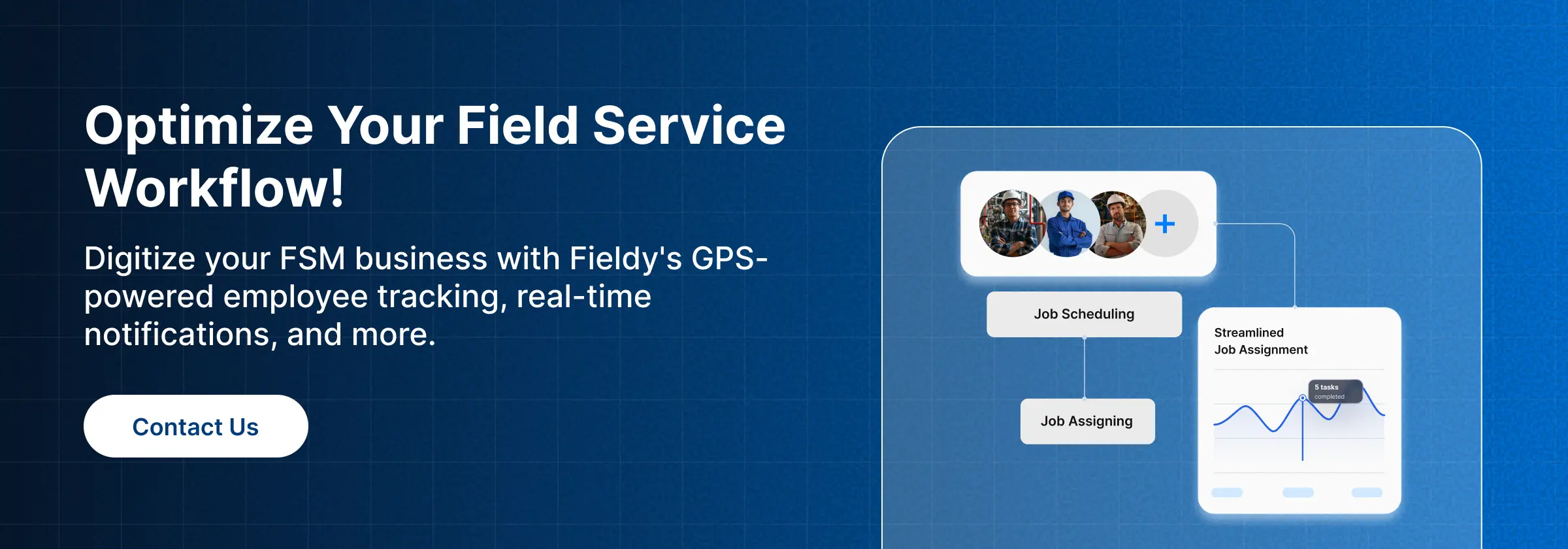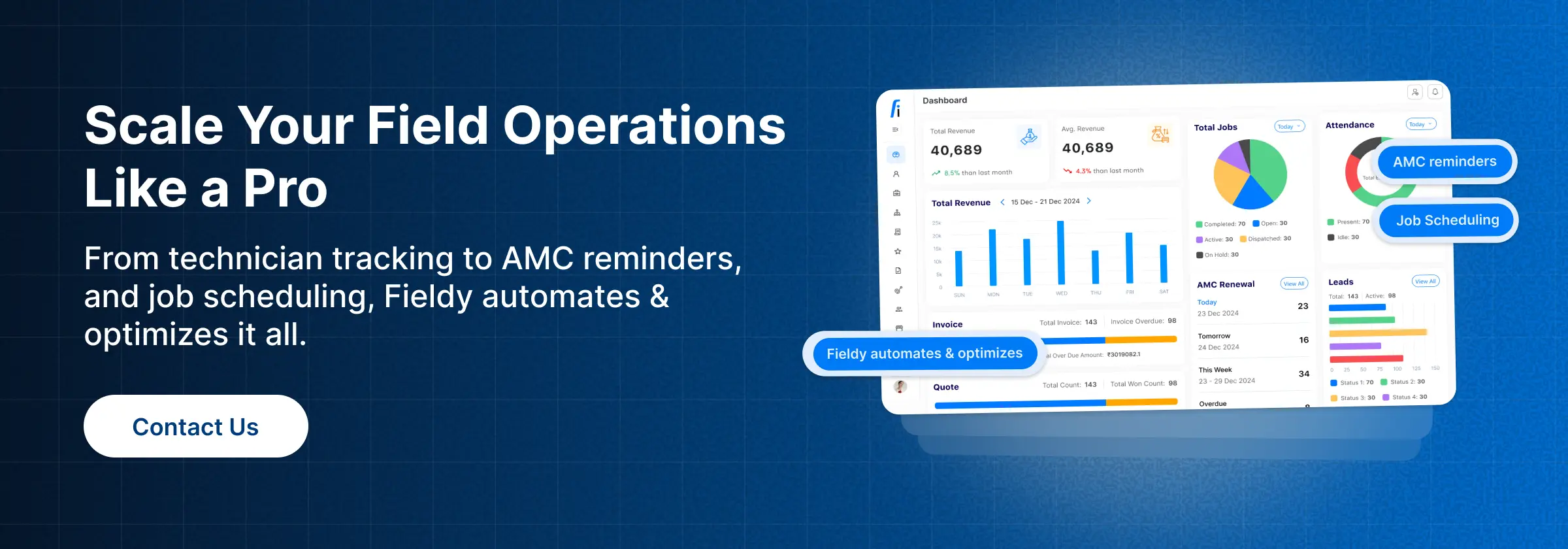👋 Introduction
🔑 Why Employee Productivity Is the Backbone of Field Service Businesses?
In the present competitive field service industry, the productivity level of employees determines profitability or loss. A late technician, a missed service window, or an undelivered instance of a contract leads to customer dissatisfaction and eventually to a revenue loss.
But this poses a bigger question that is often debated among different business owners: does monitoring employees yield higher productivity or does it sow seeds of mistrust among them?
The reality is such: given transparency and with the right tools, monitoring is not a tool of micromanagement; it fosters empowerment, accountability, and efficiency.
Solutions like Fieldy, a contemporary field service management software, are changing the way businesses are working to monitor and improve productivity. That’s to say, the current monitoring world is no more interested in watching and is keen to optimize every leading angle of field operations from GPS-based tracking to automated AMC scheduling.
📌 Why Monitoring Employee Productivity Matters in Field Service?
Employee monitoring is not about suspicion; instead, it is about visibility and optimization. In a field service industry, such as HVAC, plumbing, electrical, and IT services, monitoring will solve problems directly affecting the growth of the business. Let us now explore why each of these points holds value.
👷 Technician Accountability Issues
Being a field service operation, a technician is mostly out of the office. Without any kind of visibility, how is it possible to make sure they adhere to schedules or really report the hours they work, or are efficiently performing the jobs assigned to them? Monitoring minimizes the loopholes for noncompliance by enabling managers to have visibility on all technician activities.
Why it matters: Noncompliance means leakage of revenue and distrust among clients. An instance of missed appointments or underreported working hours could erode customer confidence very fast. Monitoring prevents these incidences from occurring.
⏰ Job Delays and Missed Schedules
Customers today expect on-time service delivery. Delays not only frustrate clients but also disrupt entire service pipelines, leading to backlogs. By monitoring schedules in real time, managers can reallocate resources or send backup technicians to minimize disruptions.
Why it matters: Research by Field Service News (2024) shows that 65% of customers are willing to switch service providers after two instances of late service. Monitoring protects customer loyalty.
👀 Lack of Visibility in Field Operations
Managers need real-time insights into technician status, location, and job progress. Without visibility, managers work reactively, only discovering problems when customers complain. Monitoring allows them to work proactively.
Why it matters: A 2023 Aberdeen study found that companies with real-time field visibility improved workforce productivity by 27% compared to those relying on manual reporting.
😡 Customer Dissatisfaction
Ultimately, poor accountability, missed deadlines, and lack of visibility converge into negative customer experiences. Dissatisfied customers leave negative reviews, reduce referrals, and churn faster.
Why it matters: A Salesforce 2024 report highlighted that 78% of customers switch providers after repeated service delays. Monitoring ensures consistent service quality, which is vital for retention.
In short, you can’t improve what you can’t measure. Monitoring provides the data and insights needed to improve field service efficiency.
🧭 How to Monitor Employee Productivity in Field Service
Wondering how to monitor employee productivity without overwhelming your workforce? The key lies in using technology smartly. With platforms like Fieldy, monitoring integrates seamlessly into daily workflows.
🛰️ GPS and Real-Time Updates
Live employee GPS tracking app capabilities ensure technicians aren’t wasting travel time or taking inefficient routes. With optimized routing, businesses reduce fuel costs and increase the number of jobs completed per day.
Industry insight: HVAC fleets spend 20–25% of operating budgets on fuel (ACCA Research, 2024). Companies that adopted GPS-enabled monitoring reduced fleet costs by 15% on average.
Example: An HVAC company reduced travel time by 18% after using employee tracking apps, allowing technicians to complete two additional jobs per day.
👥 Team Management
Field team management software assigns jobs based on technician skills and availability. This ensures that tasks are distributed fairly and that the most qualified technician handles each job.
Why it matters: Without structured team management, businesses face bottlenecks, overloading some technicians while underutilizing others. Balanced allocation improves productivity and reduces employee burnout.
📲 Real-Time Technician Tracking
Managers gain instant visibility into active jobs. Delays or missed milestones are flagged immediately, enabling quick interventions. Instead of waiting for customer complaints, issues are resolved before escalation.
Industry insight: According to Gartner (2024), businesses using real-time technician tracking improved SLA (Service Level Agreement) compliance by 32%.
📱 Field Service App
With a field staff tracking app, managers gain instant visibility into active jobs. Delays or missed milestones are flagged immediately, enabling quick interventions. Instead of waiting for customer complaints, issues are resolved before escalation.
Example: A plumbing company using a field service management app cut administrative work by 25%, freeing up time for revenue-generating tasks.
❓ Does Employee Monitoring Increase Productivity?
So, does employee monitoring increase productivity? The answer is yes, when implemented strategically.
Monitoring drives performance in multiple ways:
📋 Improved Accountability
When employees know their tasks and timelines are being tracked, they are naturally more focused and responsible. Monitoring ensures transparency, every completed job, delay, or missed deadline is visible. This discourages slacking and promotes ownership. For example, Gallup reports that employees who receive real-time feedback are 23% more likely to perform better, proving accountability drives higher output.
⚖️ Smarter Resource Allocation
Monitoring helps assign jobs based on skill, availability, and location. This prevents rework, saves travel time, and improves first-time fix rates by up to 17%. Right technician, right job, right time.
⏳ Reduced Downtime
Managers spot bottlenecks instantly with real-time tracking. Quick intervention cuts wasted hours, saving up to 2.5 hours per technician daily. Less idle time means more jobs completed.
🤝 Increased Customer Satisfaction
Customers value reliable service and accurate ETAs. Monitoring ensures transparency with live updates, which boosts trust. PwC found 73% of customers rank timeliness as the top driver of satisfaction.
🚀 Employee Empowerment
Clear metrics reduce micromanagement and give technicians control over results. This fosters trust, engagement, and higher performance, SHRM links engaged employees to a 21% productivity lift.
Industry data: Deloitte’s 2023 Workforce Report revealed that companies using transparent monitoring tools saw a 19% improvement in employee satisfaction and a 22% increase in productivity.
🏆 Best Practices for Employee Productivity Monitoring in Field Service
Monitoring is effective only when implemented with empathy and strategy. Here’s how to ensure success:
🗣️ Be Transparent
Employees should understand monitoring is designed to support, not police them. Open communication builds trust and reduces resistance.
🎯 Define KPIs
Key metrics such as job completion time, travel efficiency, first-time fix rate, and customer feedback ensure objective performance evaluation.
🤖 Automate Reporting
Manual reporting is time-consuming. Automated updates through tools like Fieldy allow technicians to focus on work while managers receive real-time data.
💬 Encourage Feedback
Create two-way communication by involving field service technicians in process improvement and overall workflow enhancements. Feedback ensures the system evolves with the team’s needs rather than staying rigid.
Example: A service company using Fieldy introduced monthly feedback sessions and saw a 15% increase in employee retention within three months.
⚖️ With vs. Without Employee Monitoring in Field Service
Monitoring is more than just tracking where your employees are, it’s about creating accountability, visibility, and operational efficiency. Let’s break down the impact of monitoring versus not monitoring in field service businesses.
✅ With Monitoring (Using Fieldy)
- Efficiency:
GPS-enabled routing and real-time location sharing ensure technicians take the most efficient paths to job sites. This reduces fuel costs by up to 18% (Field Service News, 2024) and minimizes wasted travel hours. With Fieldy, dispatchers can dynamically reroute technicians when emergencies arise, ensuring no job is delayed. - Accountability:
Real-time tracking means every job status, started, in-progress, completed, is updated instantly. Managers can see which tasks are pending, which are delayed, and why. This proactive visibility helps address issues before they escalate into customer complaints. - Customer Experience:
Today’s customers expect Uber-like transparency, knowing exactly when the technician will arrive. With Fieldy’s live ETAs and instant job updates, customers are informed in real time. Companies using such features have seen 20–25% improvements in customer retention because trust is built with consistent communication. - Employee Morale:
Monitoring isn’t about micromanagement, it’s about fairness. Fieldy enables smart job assignment based on technician skill sets, availability, and workload balance. This avoids overworking certain employees while others sit idle. Happier, fairly treated employees deliver better service, reducing turnover rates. - Revenue Growth:
When inefficiencies drop, productivity naturally rises. Optimized scheduling ensures more jobs are completed daily, which translates directly into higher revenue. Businesses using Fieldy often report 15–30% more billable hours per technician compared to those without proper monitoring systems.Example:
A medium-sized HVAC service company using Fieldy reported a 28% increase in on-time arrivals and a 21% boost in customer satisfaction scores within six months of adopting monitoring tools. The streamlined operations allowed them to handle 35% more jobs monthly without hiring additional staff.
❌ Without Monitoring
- Inefficiency:
Without GPS and route optimization, technicians often waste hours in traffic or travel inefficiently between jobs. This results in higher fuel bills and fewer service calls per day. Research shows companies without field tracking waste up to 2 hours per technician daily. - Low Accountability:
When there’s no system to track job progress, missed deadlines or incomplete tasks often go unnoticed until customers complain. Managers rely on guesswork, which leads to inconsistent service quality and customer dissatisfaction. - Poor Customer Experience:
Customers today demand accurate ETAs and reliable service. Without monitoring tools, businesses often give vague timelines, leading to frustration. A 2023 Zendesk survey found that 62% of customers stop using a service provider after just two late or missed appointments. - Employee Frustration:
Lack of visibility leads to poor workload distribution. Some technicians are overloaded while others remain underutilized, creating resentment and burnout. Overworked staff deliver poorer service, while idle technicians feel disengaged. This cycle increases turnover and recruitment costs. - Revenue Loss:
Missed jobs, rework, and customer churn all eat into profitability. Without monitoring, businesses struggle to measure technician performance, making it impossible to optimize resources. A plumbing business without tracking solutions reported a 30% higher rate of repeat complaints and lost 15% of its client base in a single year due to unreliable service.Example:
Another field service company operating without productivity monitoring found their technician idle time averaged 25% daily. This translated to nearly one lost job per technician per day, costing the company thousands in unrealized revenue every month.
The contrast is clear:
- With monitoring, businesses gain efficiency, higher accountability, better customer trust, and measurable revenue growth.
- Without monitoring, inefficiencies multiply, employee morale drops, customers churn, and revenue declines.
Employee monitoring, when done transparently with tools like Fieldy, isn’t surveillance. It’s a strategic advantage that enables businesses to scale operations, retain customers, and empower employees.
📍 Conclusion
Monitoring as a Growth Lever
So, how to monitor employee productivity effectively? The answer lies in transparency, clear KPIs, automation, and the right tools.
And does employee monitoring increase productivity? Absolutely, when implemented with strategy. It’s not about surveillance; it’s about creating an empowered workforce, optimized resources, and satisfied customers.
With solutions like Fieldy’s GPS tracking, team management, real-time updates, and field service apps, monitoring transforms from a challenge into a competitive advantage that drives growth and customer loyalty.
❓ FAQs
How to monitor employee productivity effectively in field service businesses?
A: Use tools like Fieldy that provide GPS tracking, real-time job updates, and reporting. These features ensure accurate tracking without relying on manual methods.
Does employee monitoring increase productivity in the long run?
A: Yes, when implemented transparently, employee monitoring increases productivity by reducing idle time, improving accountability, and ensuring that jobs are completed on schedule. For example, industries that use GPS-enabled tracking apps report up to a 20–25% reduction in wasted travel hours, leading to faster service delivery and happier customers.
What are the key benefits of employee monitoring software?
A: It improves visibility, ensures on-time service, and balances workloads. Tools like Fieldy help businesses boost technician performance while reducing operational inefficiencies.
What are the common mistakes companies make when trying to monitor productivity?
A: The biggest mistake is treating monitoring as surveillance. Without clear KPIs and transparency, it creates mistrust instead of motivating employees.
How can small and mid-sized HVAC or field service companies track employee productivity affordably?
A: They can adopt budget-friendly platforms like Fieldy, which offers GPS, mobile apps, and automated scheduling at $25/user without hidden costs.
Is employee monitoring ethical, and how can businesses ensure trust?
A: Yes, when done with clarity and fairness. Businesses should explain the purpose, focus on support, and involve employees in continuous improvement.




